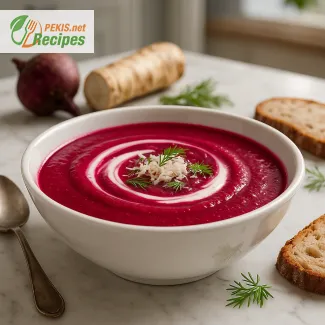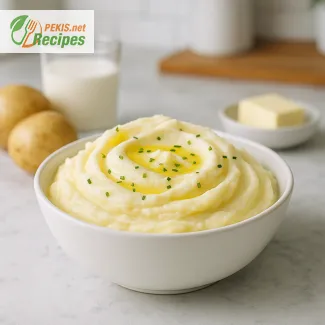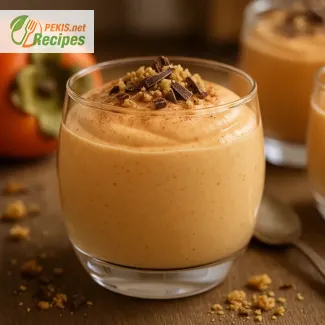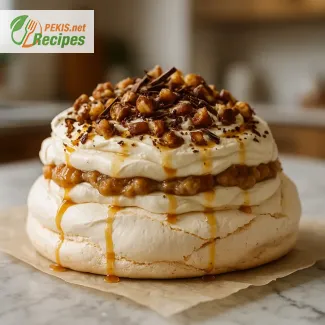Serves 4, prep 10 min, cook 25 min, total 35 min. Roasted Chestnut with Rosemary brings together creamy chestnuts, fresh rosemary, a drizzle of olive oil, and a touch of sea salt for a fragrant winter snack. The result is a warm, nutty flavor balanced with herbal brightness, perfect for gatherings or cozy evenings. Enjoy immediately or store at room temperature for 2 days, freeze for 2 months, and reheat at 150 °C for 8–10 minutes to restore texture and aroma.
PEKIS – professional chef and recipe developer with more than 25 years of experience, specialized in European and international cuisine. I’ve worked extensively with seasonal ingredients, and chestnuts have always been one of my favorites during the colder months. Creating Roasted Chestnut with Rosemary is part of my long tradition of reimagining simple winter snacks into something aromatic and memorable, combining heritage with a touch of modern flavor balance.

Winter flavors reimagined with chestnut and rosemary
The comforting charm of roasted chestnuts with fresh herbs
Few aromas capture the essence of winter evenings as vividly as the scent of roasted chestnuts slowly opening under heat. When combined with the earthy, slightly resinous note of fresh rosemary, this traditional snack becomes more than just a seasonal indulgence—it transforms into a warm, fragrant experience that bridges simplicity with culinary sophistication. The gentle sweetness of chestnuts, paired with the herb’s pine-like freshness, creates a contrast that feels both rustic and refined, ideal for gatherings, festive occasions, or as a quiet moment of comfort on cold nights.
Origins and cultural roots of chestnut roasting
The tradition of roasting chestnuts traces back centuries, especially in European regions where chestnut trees flourished in abundance. From the bustling streets of Paris in the 19th century to village markets in Italy and Spain, roasted chestnuts became synonymous with winter fairs, holiday celebrations, and shared community moments. Adding rosemary to this custom introduces a Mediterranean nuance, reflecting how regional herbs and spices have long elevated simple ingredients into signature flavors. Today, the combination stands as a timeless reminder of how food connects culture, history, and personal memory.
Sensory qualities of chestnut and rosemary pairing
Chestnuts have a naturally starchy, slightly nutty taste that turns creamy and mellow when roasted. Their mild sweetness complements the aromatic oils in rosemary, which release subtle hints of pine, lemon, and wood smoke when exposed to heat. Together, they create:
- A warm, nutty base balanced by herbal brightness.
- An inviting fragrance that enhances the festive atmosphere of winter.
- A satisfying texture—soft chestnuts enriched by crisped rosemary leaves.
Why you will love this recipe
- Simple ingredients with deep seasonal resonance.
- A comforting snack that feels both traditional and modern.
- Perfect for holiday gatherings, casual evenings, or cozy winter walks.
- Easy to prepare yet packed with aromatic complexity.
- Naturally warming and nourishing, making it ideal for cold days.
Creative variations to try
Chestnuts and rosemary form a versatile foundation that invites experimentation:
- Citrus infusion: Add a hint of orange or lemon zest before roasting for a bright, festive twist.
- Savory depth: Incorporate a sprinkle of sea salt or smoked salt to accentuate the nutty flavors.
- Spiced warmth: Blend in cinnamon or cloves for a more aromatic, holiday-inspired profile.
- Modern flair: Toss with a drizzle of olive oil and honey to balance sweet and herbal notes.
- Herbal switch: Replace rosemary with thyme or sage for a different aromatic direction.
Storage and make-ahead tips
Roasted chestnuts are best enjoyed warm, but with the right approach, they can be prepared ahead:
- Room temperature: Store in an airtight container for up to 2 days.
- Freezing: Keep peeled chestnuts frozen for up to 2 months.
- Reheating: Warm in the oven at 150 °C (300 °F) for 8–10 minutes to revive their texture and aroma.
A seasonal ritual brought into modern kitchens
In today’s culinary landscape, the act of roasting chestnuts with rosemary is more than a snack—it is a sensory ritual that connects households to the rhythms of winter. The crackling shells, the fragrant herbs, and the warm chestnut flesh invite a pause, a chance to enjoy food as tradition, memory, and comfort intertwined. Whether served on a festive table or savored quietly with a hot drink, this pairing continues to embody the magic of winter.
- Preheat the oven to 200 °C (400 °F).
- Using a sharp knife, score the chestnuts with a small cross on the flat side to prevent bursting during roasting.
- Place the chestnuts in a bowl and toss with olive oil, sea salt, and freshly chopped rosemary.
- Spread the chestnuts evenly on a baking tray lined with parchment paper.
- Roast in the oven for 20–25 minutes, shaking the tray once halfway through for even roasting.
- Remove from the oven and allow to cool slightly before peeling. Serve warm with the fragrant hint of rosemary.
FAQ questionHow do I score chestnuts for clean roasting?
Use a sharp paring knife to cut a shallow X on the flat side of each chestnut, piercing only the shell and thin inner skin (pellicle). This vent prevents bursting in the oven and creates “tabs” that make peeling easier. Keep the nuts stable by placing them flat-side up on a towel; slow, controlled cuts reduce slipping.
FAQ questionWhat oven temperature and time work best?
For even results, roast at 200 °C (400 °F) for 20–25 minutes, shaking the tray halfway. The shells should curl back at the cuts and the nuts feel tender, not chalky. If your chestnuts are large or very fresh, add 3–5 minutes; if smaller or drier, start checking at 18 minutes to avoid drying out.
FAQ questionHow can I make peeling easier after roasting?
Steam helps. Once they come out of the oven, wrap hot chestnuts in a clean kitchen towel for 5–10 minutes. The trapped moisture loosens the pellicle so you can peel while still warm. Stubborn skins? Briefly microwave 4–5 chestnuts (10–15 seconds) to re-soften the skin and continue peeling.
FAQ questionCan I use an air fryer for roasted chestnuts with rosemary?
Yes—preheat the air fryer to 190 °C (375 °F). Toss scored chestnuts with olive oil, sea salt, and fresh rosemary, then air-fry in a single layer for 15–18 minutes, shaking the basket once. You’ll get a crisp shell and a creamy interior with concentrated herbal aroma.
FAQ questionWhat seasonings pair well with rosemary for this snack?
Keep the chestnut’s sweet, nutty profile front and center. Complement with smoked salt for depth, orange or lemon zest for brightness, or a light drizzle of honey post-roast for sweet-savory balance. For a woodsy twist, swap rosemary with thyme or sage; for warmth, add a pinch of cinnamon or clove.
FAQ questionHow do I store and reheat roasted chestnuts?
Cool completely and store at room temperature up to 2 days in an airtight container, or freeze peeled chestnuts up to 2 months. Reheat on a tray at 150 °C (300 °F) for 8–10 minutes to restore soft, creamy texture and fragrant rosemary notes. Avoid microwaving for long—it can toughen the flesh.
FAQ questionHow do I know if chestnuts are fresh and worth roasting?
Choose nuts that feel heavy for their size, with smooth, glossy shells and no rattling (rattle = dried-out interior). Press gently—there should be no give. Fresh chestnuts roast to a moist, tender crumb; older ones can taste dry or mealy, even with perfect timing.
Roasted Chestnut with Rosemary embodies the warmth and fragrance of winter in a single bite. The natural sweetness of chestnuts pairs seamlessly with the earthy freshness of rosemary, creating a balance that feels both comforting and elegant. Served warm, they capture the essence of seasonal gatherings and cozy evenings by the fire.
The preparation is simple yet rewarding, relying on quality ingredients and the right balance of heat and timing. With minimal effort, you achieve a result that delivers both texture and aroma, making it suitable for festive occasions or casual snacking. The ritual of scoring, roasting, and peeling adds a sense of tradition and craft that enhances the experience.
This pairing also offers flexibility. A sprinkle of sea salt, a hint of citrus zest, or a drizzle of honey can transform the flavor profile while keeping the base intact. Whether prepared in the oven or in a modern air fryer, the outcome remains satisfying and versatile.
Beyond taste, roasted chestnuts hold a place in cultural memory, evoking street vendors, holiday markets, and shared winter moments. When elevated with herbal freshness, they become more than a snack—they are a seasonal symbol of warmth, community, and comfort.
Allergens present in the recipe:
- None
- Gluten: Not present
Tips for substitution:
- For those sensitive to herbs, replace rosemary with thyme or sage.
- To reduce sodium, omit sea salt or replace with a pinch of smoked paprika for flavor.
- Vitamin C: 24 mg – Supports immune system and skin health.
- Vitamin B6: 0.3 mg – Contributes to brain function and metabolism.
- Potassium: 715 mg – Essential for heart and muscle function.
- Magnesium: 40 mg – Important for energy production and nerve balance.
- Iron: 1.5 mg – Contributes to oxygen transport in the blood.
- Calcium: 30 mg – Supports strong bones and teeth.
- Polyphenols: 45 mg – Help protect cells from oxidative stress.
- Vitamin C: 24 mg – Strong antioxidant that combats free radicals.
- Flavonoids: 12 mg – Support cardiovascular health and anti-inflammatory response.





